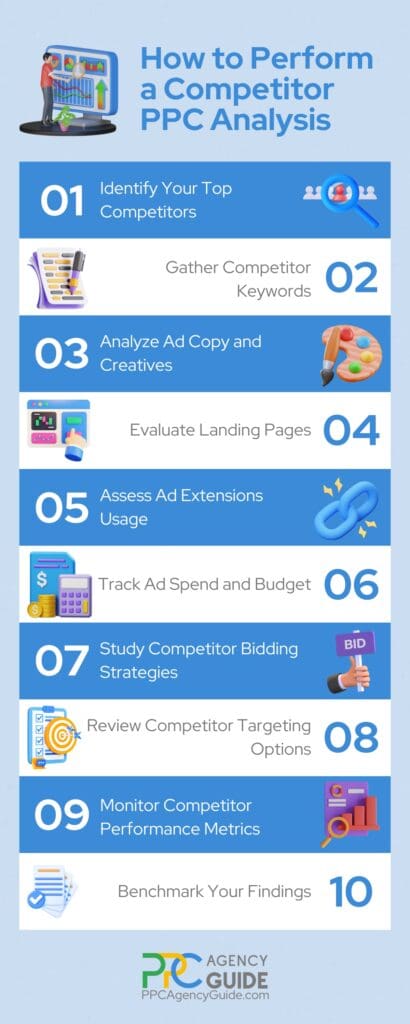
Imagine knowing exactly how your competitors are spending their ad dollars—and using that information to outperform them. That’s what a well-executed competitor pay-per-click (PPC) analysis does. It gives you a behind-the-scenes look at your rivals’ strategies, from their keyword targeting to ad copy and budget allocation. By understanding what’s working for them, you can refine your own approach and gain a competitive edge in the PPC space. In this article, we’ll walk you through the key steps of conducting an effective competitor PPC analysis and how to leverage those insights for better campaign performance.
Why Perform a Competitor PPC Analysis
Performing a competitor PPC analysis is essential for small businesses because it provides insights that can directly improve the effectiveness of your campaigns. Below, we’ll quickly review some of the reasons why it’s beneficial.
Uncover Opportunities
By analyzing competitors’ keyword strategies, you can identify gaps—keywords they might be missing, or underutilized long-tail keywords—that represent opportunities for your business. For example, if a competitor is bidding heavily on general keywords but not specific product names, you could capitalize on those niche terms.
Benchmark Your Performance
Competitor analysis allows you to measure your own PPC performance against industry standards. Use our PPC Audit Guide to ensure your campaigns align with best practices and uncover opportunities for improvement.
Are your click-through rates (CTR) and conversion rates on par? Understanding where you stand helps you know if you’re overspending or underperforming compared to others in your industry.
Improve Ad Copy and Creativity
By evaluating competitor ads, you can gain inspiration for your own campaigns. This doesn’t mean copying their approach, but rather understanding what resonates with your shared audience. For example, if a competitor uses urgency-based language like “limited time offer” and consistently ranks high, it’s a signal to refine your messaging.
Stay Competitive in Bidding
Competitor analysis helps you track how aggressively others are bidding on the same keywords. This is key to ensuring your ad isn’t overshadowed in the bidding process, especially if your competitors are spending more on high-value keywords. Tools like Google Ads Auction Insights provide direct comparisons of your impression share and rank against competitors.
Identify Market Trends
By tracking changes in your competitors’ campaigns over time, you can spot trends—like seasonal increases in ad spend or emerging keywords. This can help you pivot your strategy to stay ahead, especially during high-demand periods. For example, if you see competitors ramping up PPC efforts before Black Friday, you might want to increase your own visibility during that time too.
Optimize Landing Pages
Competitor landing pages can reveal best practices for user experience and conversion strategies. For instance, if you notice a competitor using a simple, clear CTA that drives conversions, it may inspire you to refine your landing pages. Additionally, analyzing how fast their pages load or how mobile-friendly they are can give you ideas for optimizing your own.
Cost Efficiency
By understanding how your competitors allocate their budgets, you can optimize your own spend. For example, if you discover competitors are dominating expensive keywords, you might shift focus to less costly but highly relevant terms. This can lead to a more cost-effective strategy and improve your ROI.
When to Perform a Competitor PPC Analysis
You should perform a competitor PPC analysis at several key stages in your campaign strategy to maximize effectiveness and stay competitive. Here are the best times to conduct one.
Before Launching a New Campaign
Starting with a clear understanding of what your competitors are doing ensures you enter the market with a strategy that addresses both opportunities and potential challenges. You can identify the most relevant keywords, ad copy, and audience targeting options from the outset, giving your campaign a strong foundation.
For instance, if you’re launching a new product and your competitors already offer similar products, an analysis can reveal gaps in their keyword targeting or customer pain points that you can address in your ads.

When Entering a New Market or Industry
When expanding into new markets or industries, it’s crucial to understand how established competitors are advertising and who they’re targeting. This insight helps you tailor your PPC strategy to meet local expectations and audience behavior.
For example, entering a new geographic region requires more than just translating your existing campaigns. Competitor analysis can reveal which local brands are advertising, what tone or offers they use, and which regional keywords they prioritize. If you’re expanding into Southern California, for instance, studying how a PPC agency Los Angeles structures its local campaigns can offer valuable insights into successful regional strategies.
During Performance Slumps
If your PPC campaigns are underperforming or you notice a drop in key metrics (like click-through rates or conversion rates), competitor analysis can help you identify what’s working for others and what you might be missing.
For instance, if your CTR drops suddenly, analyzing competitor ads might reveal they’ve adopted a new promotion or ad format that’s more appealing to the audience, giving you a clue to adjust your own campaigns.
Regularly as Part of Ongoing Optimization
PPC is a dynamic, competitive space, so it’s important to conduct regular analyses to keep up with changes in the market. Competitors may alter their budgets, adopt new keywords, or refine their messaging, which can impact your campaign performance.
Conducting quarterly analyses, for example, can help you stay ahead by adjusting your strategy based on seasonal trends, new competitors, or evolving audience behavior.
After Competitor Changes
If a competitor makes a major move, such as launching a new product, changing their pricing model, or increasing their ad spend, it’s a good time to assess their PPC strategy to see how it may impact you.
For instance, if a competitor lowers their prices and promotes it heavily in their PPC ads, it could drive traffic away from your campaigns, prompting a need for you to adjust your value proposition or bidding strategy.
Ahead of Major Sales or Seasonal Events
Before big sales periods, such as Black Friday, Cyber Monday, or industry-specific events, conducting an analysis ensures you’re prepared to compete during peak shopping times. You can see how competitors adjust their messaging, offers, and ad spend during these periods.
For example, if you notice competitors offering free shipping or discounts prominently in their ads ahead of a holiday season, you can decide whether to match or surpass these offers in your own PPC campaigns.
When Your Business Strategy Changes
Any significant change in your business—such as rebranding, launching a new product line, or expanding services—warrants a fresh competitor analysis. This ensures that your updated PPC strategy aligns with the current market landscape.
For instance, if you’re repositioning your brand to target a higher-end market, you’ll need to analyze how your higher-end competitors are running their campaigns and how they attract their audience.
How to Perform a Competitor PPC Analysis
Now that we’ve covered the background, let’s dig into the specifics of how to perform a competitor PPC analysis.
1. Identify Your Top Competitors
Understanding who you’re up against in the PPC space is the first step in developing a successful strategy.
Start with a Simple Search
Think like your customer and search for keywords related to your business. Look at the paid ads that appear at the top of the results. These companies are competing for the same audience, making them your primary PPC competitors.
Use PPC Tools
Leverage online tools like Semrush or SpyFu to dig deeper. These platforms allow you to input your own website or relevant keywords and will return a list of competitors, along with data like their top-performing keywords and estimated ad spend.

Analyze Google’s Auction Insights
If you’re already running Google Ads, check out the Auction Insights report. It will show how your ads perform against competitors’ ads for the same keywords, helping you identify who is consistently bidding in your space.
Don’t Forget Social Media Ads
Competitors aren’t only found in search results. Many businesses also run ads on social platforms like Facebook and Instagram. Use Facebook’s Ad Library to see what ads your competitors are running.
Listen to Your Customers
Sometimes, your customers can be the best source of competitor information. Ask them where else they considered buying or what other services they looked into. This can help uncover competitors that may not be visible in search results. Use tools like Google search, industry reports, or PPC analysis tools to identify direct competitors.
2. Gather Competitor Keywords
Once you’ve identified your top competitors, the next step is to understand which keywords they’re targeting in their PPC campaigns. This insight will help you refine your own keyword strategy and spot opportunities to outperform them.
Use Keyword Research Tools
Tools like Semrush, Ahrefs, SpyFu, and Keyword Planner can show you the keywords your competitors are bidding on. By inputting a competitor’s URL or target keyword, you can access a list of relevant terms along with valuable data like search volume, cost-per-click (CPC), and competitive density.
For instance, if you’re in the fitness industry and type in a competitor’s domain, Semrush might reveal they’re bidding heavily on terms like “personal trainer near me” and “online fitness programs.”
Look for Branded and Non-Branded Keywords
Competitors typically bid on both branded and non-branded keywords. Branded keywords include their company or product names, such as “Nike running shoes,” while non-branded keywords target more general search terms, like “best running shoes.” Both are important to monitor.
Pro Tip: Bidding on competitor-branded terms (bidding on “Nike shoes” when you sell athletic shoes) can help you “steal” traffic, but it’s a strategy to use with care, as it can be costly and may not always yield high conversions.
Analyze Long-Tail Keywords
Long-tail keywords are longer, more specific phrases that often have lower search volume but are highly targeted. Competitors may be using these to reach niche audiences. Tools like Ubersuggest or AnswerThePublic can help uncover long-tail keywords that competitors might be targeting.
For example, instead of just bidding on “fitness programs,” a competitor might use long-tail keywords like “beginner-friendly online fitness programs” to attract a more specific audience.
3. Analyze Ad Copy and Creatives
Once you’ve gathered competitor keywords, the next step is to understand how your competitors are using those keywords in their ad copy and visuals. This insight helps refine your own ads by highlighting effective messaging and design strategies.
Review Competitor Headlines and Descriptions
Start by searching for industry keywords and examining the headlines and descriptions in competitor ads. Look for consistent themes, such as promotions, benefits, or features they emphasize.
Evaluate Calls to Action (CTAs)
CTAs are crucial for conversions. Check the language competitors use to prompt action, such as “Buy Now,” “Get a Free Quote,” or “Sign Up Today.”
Analyze Visual Creatives (for Display Ads)
For display ads, visuals are key in attracting attention. Review competitors’ display ads to analyze their use of images, colors, and design elements.
Check Ad Extensions Usage
Ad extensions, such as site links, call buttons, or location information, can enhance ad visibility. See if competitors are using these features to improve their ads and provide more value to users. If so, look for commonalities in what they’re using.
4. Evaluate Landing Pages
After analyzing ad copy and creatives, the next crucial step is to evaluate your competitors’ landing pages. The landing page is where users go after clicking on an ad, and its design, content, and user experience play a big role in converting clicks into sales.
Examine the User Experience (UX)
Visit your competitors’ landing pages to analyze the overall user experience. Look for how easy it is to navigate, how quickly the page loads, and how mobile-friendly it is.
Assess the Call-to-Action (CTA)
Pay close attention to the call-to-action on the landing page. Determine whether the CTA is clear, prominent, and easy for users to act on.
Review Content and Messaging
Analyze the content on the landing page to understand how competitors are presenting their product or service. Look at the headline, supporting text, and any visuals they use to communicate their value proposition.
Look for Conversion Elements
Identify key conversion elements such as forms, chatbots, or special offers. See if competitors are using strategies like offering discounts or using urgency tactics like a limited-time offer to encourage users to act quickly.
5. Assess Ad Extensions Usage
Ad extensions are powerful tools in PPC that add extra information to your ads and can significantly enhance visibility and engagement. Evaluating how your competitors use ad extensions can give you ideas for improving your own ads.
Check for Site Link Extensions
Look at whether your competitors are using site link extensions, which provide additional links beneath the main ad. These links can guide users to specific pages like product categories, contact forms, or special offers.
Evaluate Call Extensions
Review whether competitors include call extensions in their ads, especially for industries where phone inquiries are important. Call extensions allow users to call the business directly from the ad with one click.
Look for Location Extensions
See if your competitors are using location extensions to display their business address alongside their ads. This is particularly useful for businesses with physical locations and helps attract local customers.
Check for Price and Promotion Extensions
Look for ads that display price or promotion extensions, which show specific product prices or special deals directly in the ad. These can help make the ad more attractive by highlighting competitive pricing or limited-time offers.
6. Track Ad Spend and Budget
Understanding how much your competitors are spending on PPC and how they allocate their budget can offer valuable insights for your own strategy. Tracking competitor ad spend helps you gauge how aggressive they are in the market and whether there are opportunities to compete more effectively.
Use PPC Tools to Estimate Competitor Ad Spend
Utilize tools like Semrush, SpyFu, or iSpionage to estimate how much your competitors are spending on their PPC campaigns. These tools provide approximate monthly or yearly ad budgets based on keyword usage and traffic data.
For example, if a competitor is estimated to spend significantly more than you on certain keywords, they might be dominating those terms, which can guide you to focus on different keywords or increase your own spend in key areas.
Analyze Budget Allocation by Campaign Type
Look at how competitors allocate their budget across different campaign types—such as search ads, display ads, or shopping ads. This can reveal where they’re focusing their efforts.
Identify High-Spend Keywords
Focus on the high-value keywords where competitors are investing the most. Tools like Google Ads Auction Insights can help show how much share of voice competitors have for certain keywords, indicating higher spending on those terms.
Monitor Seasonal Ad Spend Trends
Track how competitors adjust their ad spend during different times of the year, especially around major sales seasons or industry-specific events. This can give you insights into their strategic priorities and help you plan your own budget accordingly.
7. Study Competitor Bidding Strategies
Understanding how your competitors are bidding on keywords can help you refine your own approach. By analyzing their bidding strategies, you can identify opportunities to adjust your bids and improve your ad ranking without overspending.
Analyze Bidding Aggressiveness
Use tools like Google Ads Auction Insights to see how your competitors rank for shared keywords. This tool shows how frequently their ads appear compared to yours, giving you insight into how aggressively they’re bidding.
Identify Manual vs. Automated Bidding
Look at whether competitors are using manual bidding or automated bidding strategies. Manual bidding allows them to control how much they pay for each click, while automated bidding relies on algorithms to maximize results based on their goals.
Monitor Bid Adjustments for Device, Location, and Time
Study how competitors adjust their bids based on device, location, or time of day. These adjustments allow them to target specific audiences more effectively.
Watch for Seasonal or Event-Based Bidding Changes
Keep an eye on how competitors adjust their bids during special events, holidays, or peak seasons. This can give you insight into their strategy during high-demand periods.
8. Review Competitor Targeting Options
Understanding how your competitors are targeting their ads can help you fine-tune your own audience targeting strategy. By reviewing their geographic, demographic, and audience segmentation tactics, you can uncover opportunities to reach untapped audiences or improve your ad performance.
Analyze Geographic Targeting
Use tools like Semrush or SpyFu to identify the regions where competitors are focusing their ads. This could include local, national, or international campaigns, depending on your industry.
Review Demographic Targeting
Evaluate the demographic data of competitors, such as the age, gender, or income level they are targeting with their ads. This information can often be found in audience data reports from tools like Facebook Ads Manager or Google Ads Audience Insights.
Assess Audience Segmentation and Retargeting
Check if competitors are using specific audience segments or retargeting strategies to show ads to people who have already interacted with their brand.
Examine Interest and Behavior-Based Targeting
Look at the interests and behaviors competitors are targeting, such as lifestyle preferences or purchase behaviors, using tools like Facebook Ads Library or Google Display Network.
9. Monitor Competitor Performance Metrics
Tracking your competitors’ performance metrics allows you to understand how well their PPC campaigns are performing. This insight helps you benchmark your own campaigns and identify areas for improvement.
Track Click-Through Rates (CTR)
Use tools like Semrush or SpyFu to estimate your competitors’ click-through rates for specific keywords. This helps you gauge how well their ads are attracting clicks compared to yours.
Review Conversion Rates
Estimate competitors’ conversion rates through tools like iSpionage, which can provide insights into how well their ads are converting clicks into customers.
Analyze Impression Share
Check your competitors’ impression share using Google Ads Auction Insights. Impression share shows how often your competitors’ ads are appearing relative to the total possible impressions.
Measure Ad Position
Tools like Google Ads Auction Insights also allow you to see where your competitors’ ads are ranking. If they consistently rank higher, they may have more optimized bidding strategies or ad relevance.
Monitor Quality Score
Estimate your competitors’ quality score by looking at factors like ad relevance, landing page experience, and expected CTR. Higher quality scores lead to better ad rankings and lower cost-per-click (CPC).
10. Benchmark Your Findings
Once you’ve gathered all your competitor insights, the final step is to benchmark your findings against your own PPC performance. This comparison helps identify strengths, weaknesses, and areas where you can improve to stay competitive.
Compare Keyword Performance
Assess how your keyword strategy stacks up against competitors in terms of search volume, cost-per-click (CPC), and click-through rates (CTR). Use tools like Semrush or Ahrefs to evaluate both your and your competitors’ keyword performance.
Evaluate Ad Copy Effectiveness
Compare your ad copy and creatives with your competitors’ ads. Look at how your headlines, descriptions, and CTAs perform relative to theirs, especially in terms of CTR and conversion rates.
Assess Landing Page Experience
Review the user experience and conversion rates of your landing pages compared to competitor landing pages. Evaluate load times, mobile optimization, and overall design.
Analyze Ad Spend Efficiency
Benchmark your ad spend and budget against competitors. Determine whether you are over- or under-spending relative to their estimated budget while also factoring in your return on ad spend (ROAS).
Compare Bidding Strategies
Look at how your bidding strategies compare to competitors’ approaches in terms of manual vs. automated bidding and bid adjustments for different devices, locations, or times.
Get a Professional Competitor PPC Analysis
Competitor PPC analysis is crucial because it reveals how your competitors are targeting keywords, structuring their ads, and spending their budget, giving you valuable insights to improve your own campaigns. However, navigating complex tools and strategies can be time-consuming and challenging. An experienced PPC agency can handle the analysis with expert precision, ensuring your campaigns are optimized for maximum ROI while staying ahead of the competition. To be matched with a PPC agency that can help, request a complimentary consultation.
Why is competitor PPC analysis important for my business?
Competitor PPC analysis helps you discover opportunities to outperform rivals. By studying their ads, keywords, and budget, you can identify gaps in their strategy and uncover potential keywords or audience segments they're missing. It also allows you to benchmark your own performance and refine your PPC efforts to maximize conversions and stay competitive.
How do I identify my competitors in PPC advertising?
To identify your competitors, start by searching your target keywords on Google and noting which ads appear in the results. You can also use tools like Semrush, SpyFu, or Ahrefs to see which businesses are competing for the same keywords. Don’t overlook indirect competitors who may offer different products but target the same audience through PPC.
What tools can I use to analyze competitor PPC campaigns?
Tools like SEMrush, SpyFu, iSpionage, and Ahrefs are great for analyzing competitor PPC campaigns. These tools can show you competitors' top keywords, estimated ad spend, click-through rates (CTR), and more. Google’s Auction Insights can also provide insights into how your ads perform against competitors for the same keywords.
How can I track my competitors’ ad spend in PPC?
Tools like SpyFu, Semrush, and iSpionage provide estimates of how much competitors spend on their PPC campaigns. These tools can show monthly and yearly ad spend, helping you gauge how aggressive they are in the market. You can also use Google’s Auction Insights to compare your ad’s impression share with competitors.
What should I look for when analyzing competitor ad copy?
When analyzing competitor ad copy, focus on their headlines, descriptions, and calls to action (CTAs). Look for recurring themes, such as promotional offers, benefits, or emotional triggers like urgency or trust. Also, assess whether they use ad extensions like site links or call buttons to enhance visibility and engagement.
How do I monitor my competitors’ bidding strategies in PPC?
You can monitor competitors' bidding strategies using tools like Google Ads Auction Insights, which shows how often their ads appear and their ad ranking for specific keywords. Tools like SpyFu can also help estimate whether competitors are using manual or automated bidding strategies. Monitor seasonal changes in bids for keywords to spot trends.
How can I find the keywords my competitors are bidding on?
Tools like Semrush, Ahrefs, and SpyFu can help you discover the keywords your competitors are bidding on. Input your competitor’s URL or relevant keywords to access a list of their top-performing keywords, search volumes, and cost-per-click (CPC) data. These insights help you optimize your own keyword strategy.
What are ad extensions, and how do competitors use them?
Ad extensions are additional pieces of information that enhance ads, such as site links, call buttons, or price extensions. Competitors use these to provide more value, increase ad visibility, and drive more engagement. You can assess how they use extensions by reviewing their ads on Google or using tools like Semrush.
How do I benchmark my PPC performance against competitors?
Benchmarking involves comparing your PPC performance metrics (like click-through rates, conversion rates, and ad spend) to those of your competitors. Tools like Semrush, Google Ads Auction Insights, and SpyFu help you track how your ads rank, perform, and convert compared to competitors, allowing you to identify opportunities for improvement.

















